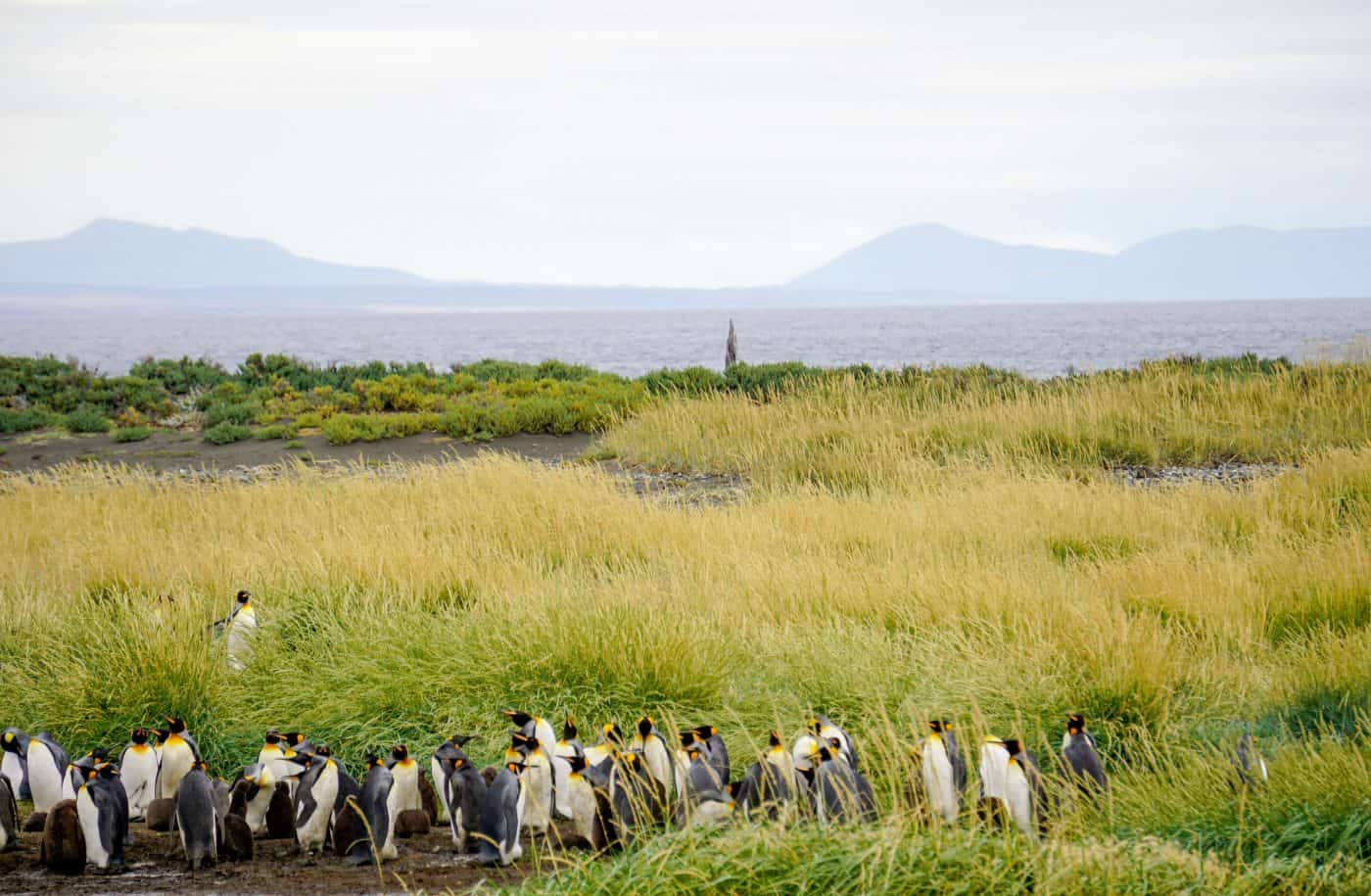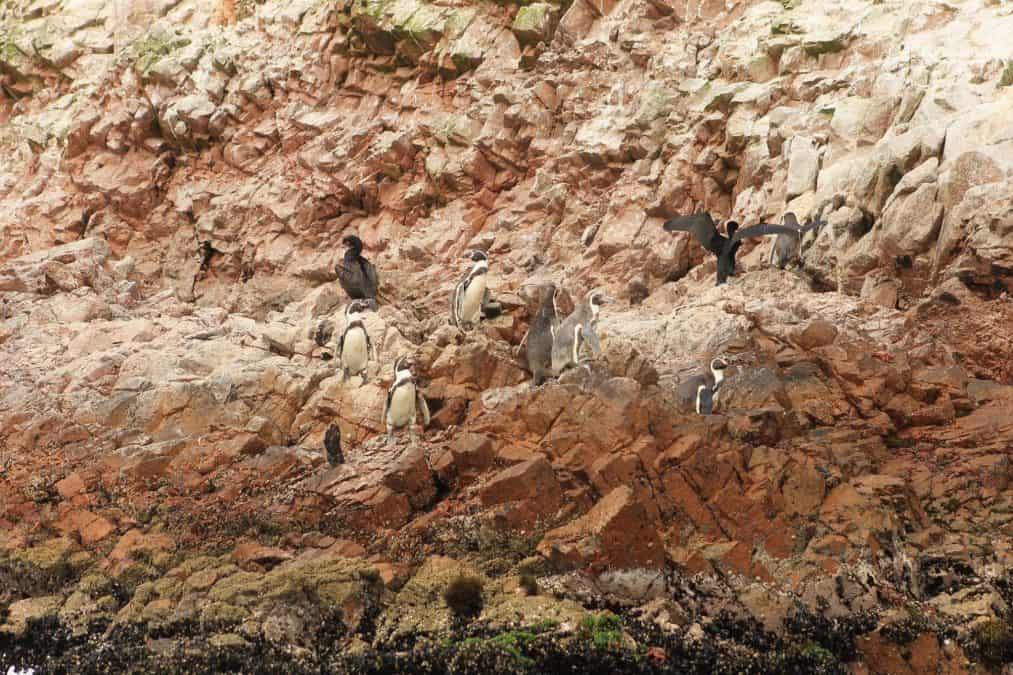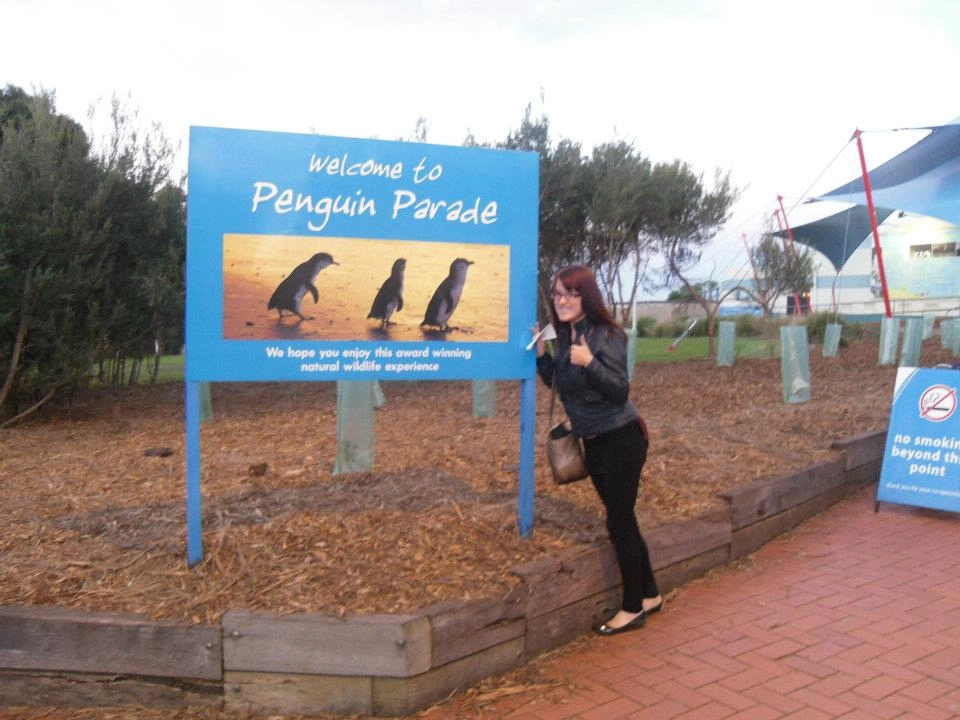This post may contain affiliate links. By clicking and making a purchase through the links, I earn a small commission at no extra cost to you. See my disclaimer for more information. This and display ads allow me to keep the site up to date and give back.
There are 17 species of penguins and it is one of my life goals to see them all in the wild. I’ve been obsessed with penguins for as long as I can remember. I just love everything about them – so silly, loyal, and cute. So far I’ve managed to see 6/17 species of penguins, so I thought it would be fun to share all the places you can see penguins in the wild, which are basically my future travel plans.
You may think you have to venture out to Antarctica to see penguins in the wild, but this isn’t the case at all. You can actually find penguins on warm and sunny beaches!
Best Places to See Penguins in South America
Outside of Antarctica, South America is one of the best places to see penguins. There are several species found throughout Patagonia, as well as the Falkland Islands, Peru, and the Galapagos Islands.
Where to See Penguins in Argentina
Patagonia is a great place to see penguins in the wild. There are several places where you can see penguins in both Argentina and Chile.
One of the best places to see penguins in Argentina is in Ushuaia, the most southerly city in the world that is known as being the gateway to Antarctica. Makes sense there would be penguins there! One of my main motivations to visit here was to go walking with penguins on Martillo Island.

The main type of penguins that live here are Magellanic penguins, which are small black and white ones. They live on Martillo island which is only accessible by organized tours, so you need to book with a tour company in advance as they only allow a limited number of guests on the island at once. It’s an amazing experience, there were hundreds of penguins greeting us once we arrived!

There is also a small colony of gentoo penguins on Martillo Island that you can see, which are the penguins with distinctive orange on their feet and peaks. To all of our surprise, we also saw one lone king penguin on the island! The guide didn’t know why he was there – perhaps a lost explorer?

The best time to visit the penguins here is from November and February as this is when the population is highest. They start to head North in March, so you won’t be able to see them after this.
Another place to see penguins in Argentina is Punto Tombo National Reserve, which is further north. It’s home to the largest population of Magellanic penguins. I didn’t get a chance to visit here, but it looks like an amazing place for marine life!
Where to See Penguins in Chile

There is a small colony of king penguins in Tierra Del Fuego at Parque Pingüino Rey/King Penguin Park which is the only king penguin colony in South America outside of Antarctica (with the exception of the lone king penguin I saw in Ushuaia).
I did a day tour here from Punto Arenas, but it wasn’t my favorite wildlife experience. While it’s amazing to watch them all huddling around each other making sounds, there’s a wall that keeps you about 15m back from them. They do have some telescopes to get a better look, but overall I enjoyed the penguin walk in Ushuaia much more.
There is also a large colony of Magellanic penguins that you can see near Punto Arenas on Magdalena Island. It has been named the Los Pingüinos Natural Monument as it is estimated there are over 60,000 breeding pairs! The best time to visit is between October and March when they are nesting.
On the island of Isla Damas, you can find the Humboldt Penguin National Reserve which is an important breeding site for Humboldt penguins.
Penguins on the Falkland Islands

There are more penguins than people on the Falkland Islands! Never has a statement made me want to visit somewhere so badly. It’s thought that there are nearly one million Penguins there! It’s actually a pretty interesting story of how so many penguins ended up here, There are five species of penguins you can see on the island: King, Magellanic, Gentoo, Macaroni, and Rockhopper.
The Falkland Islands are HIGH on my bucket list. While it is technically part of the UK, the islands are located off the coast of Argentina. Many cruise ships go here, but you can also fly onto the islands and explore on your own. Flights leave from Santiago, Chile and Sao Paulo, Brazil.
Penguins in Peru

Nicknamed the “Poor Man’s Galapagos” the Ballestas Islands in Peru are one of the richest marine habitats in the country. It’s relatively easy to get here. You have to get to Paracas first, which is a lovely beach down about a four-hour drive from Lima, and then take a boat tour from there.

I booked mine through Peru Hop, and had an amazing time. The boat tour goes around the islands, where you’ll see the endangered Humboldt penguins along with a ton of other marine life. I loved this experience, it’s one of the most amazing things to do in Peru!
Where to See Penguins on The Galapagos Islands

Ahhh the Galapagos, my favorite wildlife destination in the world. There are so many amazing animals you can see here, but one that’s very special is the Galapagos Penguin. These tiny penguins are the second smallest in the world, just under 1.5 feet tall. They are the only penguin species to live north of the equator, and the Galapagos Islands are the only place you can see them.
What’s amazing about the Galapagos Islands is that it’s one of the only places in the world where you can go swimming with penguins! I wasn’t so lucky to find them in the water, but I did see them on a day tour around Los Tuneles on Isabella Island.
About 90 percent of the Galapagos penguins are living on Fernandina Island and Isabela Island, so this is the best place to look for them. If you’re island hopping in the Galapagos (aka not on a cruise), the easiest way to see the penguins is on Isabella Island as you can get here on a regular ferry that goes between the main islands.
Penguins in Africa
Where to see penguins in South Africa

South Africa is home to the most chilled out penguins in the world. They can be found hanging out on the sandy beaches of boulders beach. It’s become an insta-famous shot; sharing the sand and surf with a group of adorable African penguins. At the beach, there is a viewing boardwalk that goes over the main penguin refuge area, but you can also see them just hanging out on the beach. This is another place that’s HIGH on my list!
African penguins also live in Namibia, but from what I can tell from my research it seems to be much more difficult to see them there as opposed to South Africa as they live on remote islands.
Penguins in Oceania
Where to See Penguins in Australia

Australia is home to the smallest species of penguin, the aptly named little penguin, or sometimes referred to as fairy penguin. This species can be found on the southern shores of Australia and New Zealand.
The easiest place to see these penguins is on Phillip Island where they put on a famous nightly parade. Yes, you read that right. A penguin parade! Every night of the year about an hour before sunset, thousands of penguins return to shore after a long day of fishing to rest for the night. It’s become a tourist attraction, where you can pay to sit on a bandstand and watch the cutest parade in existence.
I witnessed this adorable parade years ago while I was visiting Australia during my semester abroad in New Zealand. It’s fun!
Where to See Penguins in New Zealand

New Zealand is one of the best places to see penguins in the world. The country is home to five different species of penguins including fiordland crested penguins, erect-crested penguins, yellow-eyed penguins, snare penguins, and little penguins. Sadly, even though I lived in New Zealand for a semesters studying I did not see any while I was there. Curse my student budget!
New Zealand is home to the same little penguins found in Australia, although they are commonly referred to as blue penguins here. This is the most common penguin sightings in New Zealand. You can see them when they come onshore as far north as Auckland all the way to Stewart island.
There are also several species of penguins that are endemic to New Zealand which are more difficult to see. One of these is the Fiordland crested-penguin. The best viewing sites for these penguins are Stewart Island off the South Island, and Munro beach.
Another rare species of penguins you can see in New Zealand are the snares crested penguins, which look similar to the Fiordland crested. They are only found on the remote Snares Islands, about 100 km south of Stewart Island. There is also the erect-crested penguin, whose breeding grounds are on the remote Bounty and Antipodes Islands.
Lastly, the yellow-eyed penguin can be found on the Otago Peninsula. There is a ‘penguin place‘ conservation reserve you can visit in Dunedin, which is a tourism-funded conservation program.
Penguins in Antarctica

Antarctica is the motherland of Penguins. The largest populations of the largest number of species occur here. There are seven penguin species you can see in Antarctica, two of which live exclusively on the continent. These include the emperor penguin, which is the largest of all penguins at almost 1.3m tall, as well as the Adelie penguin. You can also see Gentoo, Chinstrap, King, Macaroni, and Rockhopper penguins in Antarctica.
Unfortunately going to Antarctica is not an easy undertaking! There are plenty of cruise ships going there, but it’s going to cost you a pretty penny. If you do decide to go, I recommend using G Adventures. They are an amazing group tour company with a focus on responsible travel.
Summary of Where to See Penguins In The Wild
| Type of Penguin | Country Found |
| Emperor | Antarctica |
| King | Argentina, Chile, Falkland Islands, Antarctica |
| Gentoo | Argentina, Falkland Islands, Antarctica |
| Magellanic | Argentina, Falkland Islands, Chile |
| Galapagos | Ecuador |
| Little/Fairy | Australia, New Zealand |
| Humboldt | Peru, Chile |
| African | South Africa, Namibia |
| Rockhopper | Antarctica, Falkland Islands |
| Fiordland crested | New Zealand |
| Snares | New Zealand |
| Yellow-Eyed | New Zealand |
| Macaroni | Falkland Islands, Antarctica, Chile, Argentina |
| Adelie | Antartica |
| Chinstrap | Antartica |
| Erect-Crested | New Zealand |
Tips for Viewing Wild Penguins

When viewing penguins in the wild, or any wildlife for that manner, you should always be respectful of them by following these guidelines:
- Do not disturb the penguins or the places that they live
- Do not feed them
- Keep a safe distance
- Do not harass them in any way
- Do not interfere with mating, predation, or other natural behavior
- Preserve the habitat by following “leave no trace” principles
- If you are booking with a tour operator, ensure that they are ethical and following the same guidelines
Some penguin species are considered endangered, so it’s very important to follow these guidelines to help their survival so future generations can enjoy these amazing species as well.
—
It isn’t going to be an easy task to see all these penguin species but I couldn’t be more excited for the challenge. If you’re a penguin lover like me, I hope this post could inspire you to add some new destinations to your bucket list! Tell me, have you seen penguins in the wild before? Where did you find them?
FAQ: Best Places To Encounter Different Penguin Species
Where is the best place to see wild penguins?
The best place to see wild penguins is in Antarctica, where you can find the largest variety and numbers of penguins.
What country has the most different varieties of penguins?
Argentina and Chile are top contenders, offering a chance to see several varieties including King, Magellanic, and Gentoo penguins.
Where is the largest penguin colony in the world?
The largest penguin colony in the world is on Zavodovski Island, Antarctica, home to over a million Chinstrap penguins.
Where in the world can you swim with penguins?
You can swim with penguins in the Galapagos Islands, where the unique Galapagos penguin resides.
What is the best time to visit penguins?
The best time to visit penguins is during the Southern Hemisphere’s summer months, from November to February, which is their breeding season.
Can you touch a penguin?
No, you should not touch penguins as it can disturb them and potentially harm their health.
Are penguins friendly or not?
Penguins are generally not aggressive to humans, but like any wild animal, they should be observed from a distance without attempting to interact closely.
How do penguins communicate with humans?
Penguins do not communicate directly with humans, but their behaviors and reactions can provide insights into their state of comfort or distress.
How do you see penguins?
You can see penguins by visiting their natural habitats or through guided tours that respect wildlife and conservation guidelines.
What should we do to protect penguins?
To protect penguins, support conservation efforts, follow responsible wildlife viewing guidelines, and reduce environmental impacts like plastic pollution and climate change.
Final Thoughts: Where To See Different Species of Penguins
As we come to the end of this penguin-packed journey, it’s clear that these charming birds offer us a window into the diverse and fascinating corners of our planet. From the icy landscapes of Antarctica to the sunny shores of South Africa and the remote islands of New Zealand, each destination we’ve explored brings its unique flavor to the penguin-watching experience. Whether you’re dreaming of swimming with penguins in the Galapagos or witnessing the grandeur of a million-strong colony in Antarctica, there’s a penguin adventure out there for every wildlife enthusiast.
Remember, while these creatures are adorable and often seem approachable, it’s crucial to respect their space and habitat. By choosing responsible tours and adhering to conservation guidelines, we can ensure that penguins continue to thrive in their natural environments. So, pack your binoculars, charge your camera, and set off on a journey to witness these incredible birds in their natural habitats. Who knows, you might just find yourself ticking off a few more species from your penguin bucket list!
🐧 Happy penguin spotting! 🌍✨
Enjoyed this post? Pin it for later!



Leave a comment